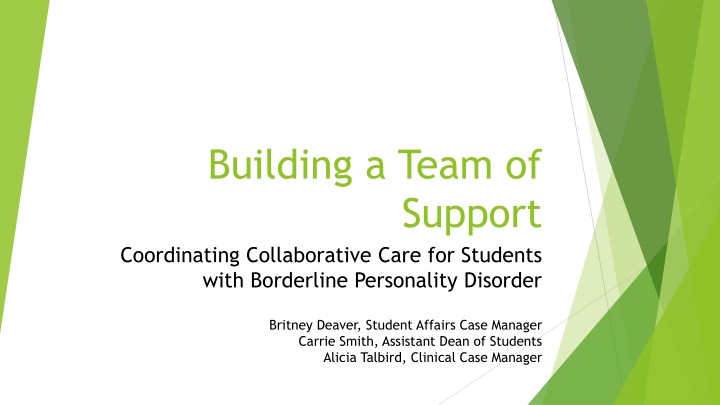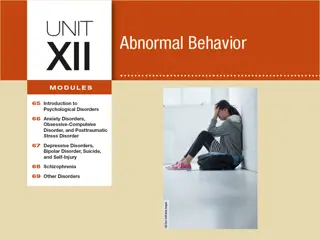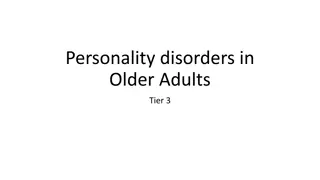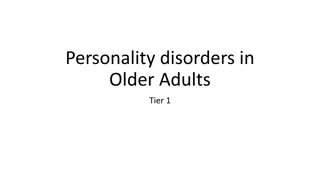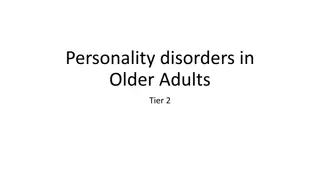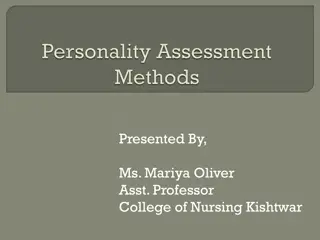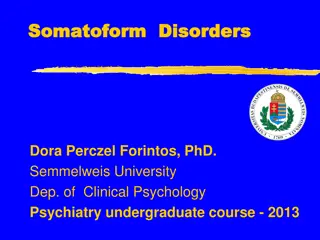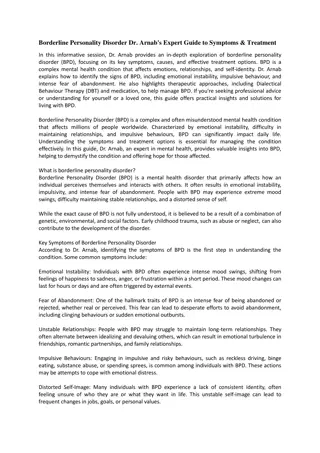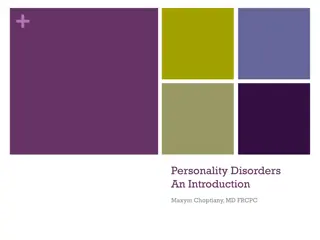Building a Team of Support for Students with Borderline Personality Disorder
Creating a collaborative care team is essential in supporting students with Borderline Personality Disorder (BPD). This involves understanding the clinical and nonclinical contexts surrounding BPD, such as the prevalence of the disorder, common symptoms, and challenges faced by individuals. The team should consist of professionals like student affairs case managers, clinical case managers, and assistant deans to provide comprehensive support and accommodations for students with BPD. By addressing the unique needs and challenges associated with BPD, the team can help students navigate university life more effectively.
Download Presentation

Please find below an Image/Link to download the presentation.
The content on the website is provided AS IS for your information and personal use only. It may not be sold, licensed, or shared on other websites without obtaining consent from the author.If you encounter any issues during the download, it is possible that the publisher has removed the file from their server.
You are allowed to download the files provided on this website for personal or commercial use, subject to the condition that they are used lawfully. All files are the property of their respective owners.
The content on the website is provided AS IS for your information and personal use only. It may not be sold, licensed, or shared on other websites without obtaining consent from the author.
E N D
Presentation Transcript
Building a Team of Support Coordinating Collaborative Care for Students with Borderline Personality Disorder Britney Deaver, Student Affairs Case Manager Carrie Smith, Assistant Dean of Students Alicia Talbird, Clinical Case Manager
Nonclinical Context: Heres what we know University must make reasonable accommodations for students with disabilities The profile of a college student continues to change and become more complex Additional access to mental health resources and information has increased familiarity with symptoms, diagnosis, treatments, and language Student services, including nonclinical and clinical services, continue to expand to meet the high demand Perfectionism as a more prevalent cultural characteristic the pressure to be successful
Clinical Context: Heres what we know Roughly 2% of the adult population have a diagnosis of Borderline Personality Disorder (Lenzenweger, Lane, Loranger, & Kessler, 2007) Sparse data related to the university and college population (Hersh, 2013) Borderline Personality Disorder (BPD) accounts for 20% of psychiatric hospitalizations (Zanarini & Frankenburg, in press) Psychiatric disabilities, including borderline personality disorders, are one of the fastest growing categories of disability (Belch, 2011) BPD behaviors begin to manifest in early adulthood
Borderline Personality Disorder Symptom In Practice I have no friends. No one cares about me. Difficulty with emotional regulation Constantly self-sabotaging goals; changing course of study abruptly Chronic instability in early adulthood Swinging from idealization to devaluation (NASET, 2007) Unstable patterns of social relationships I ve never felt good before General Mood Concerns Irresponsibility with money, substance abuse, binge eating, unsafe sex Impulsive and often dangerous behaviors Anxious efforts to avoid abandonment Changing care providers, frequent use of on-call services
Self-Injury, Para-suicidal, and Suicidal Behaviors High rate of self-injury without suicidal intent (NASET, 2007) Para-suicidal behaviors Taking enough medicine to harm, but not kill Holding a sharp object to your body without cutting yourself Standing on the edge of a ledge, but not jumping 4-8% of adults with BPD die by suicide For university officials is there a difference in how we respond to each?
Case Study: Samantha 19 y/o female Second year, undergraduate Transfer student Lives on-campus with one roommate 3.8 GPA
Timeline ODOS receives police report regarding a student transport to the hospital after ingesting several Wellbutrin Simultaneously, the Collegiate Recovery Community calls to report that one of their members tried to commit suicide and they are unsure the details They are at the student s bedside in the hospital Student involuntary transported for in-patient hospitalization for five days BIT, including Counseling Center, is informed ODOS receives call from the conduct representative on the BIT stating his concern given her recent selection for student judiciary Upon release, mother schedules a meeting with CRC representative and ODOS
Small group discussion questions What campus partners need to be involved in the meeting? How do you manage information sharing given privacy restrictions? What is your responsibility to the institution and/or to the student?
Lessons learned Nonclinical case managers: Our job is not to diagnosis or treat BPD! Counseling center must be the expert Nonclinical case managers are responding to behavior and not to any diagnosis that has been disclosed or self-reported Setting and maintain boundaries with the student while still providing care Reinforcing the policies of our partners Consistent, scheduled communication and check-ins Managing frustration and our own feelings and fatigue Cooperation and relationships are key Stay in your lane.
Questions Britney Deaver, Student Affairs Case Manager Britney.kelley@uga.edu Carrie Smith, Assistant Dean of Students cvsmith1@uga.edu Alicia Talbird, Case Manager, Counseling and Psychiatric Services (CAPS) atalbird@uhs.uga.edu
Collaborative Information Gathering CRC recently joined group, attends meetings, references substance abuse without much detail; reports of risky sexual behavior with other members from members of CRC CAPS September 2016 student schedules intake, rescheduling multiple times in one month Referred out during intake because she needs long-term services October 2016 Student appears at CAPS for crisis services with a different clinician, given more referral options and scheduled for a case management appointment No show for case management appointment and does not respond to follow up February 3 2017 Schedules another in-person screening with the original clinician and schedules a case management session for the following week February 7 2017 Walks in for crisis services, makes a safety plan, and she says she has an appointment set up with a provider for February 10. February 9 2017 Samantha is hospitalized after ingesting several Wellbutrin Housing Check in with Residence Hall staff who report that Samantha s roommate says she is always talking about taking a lot pills so she didn t notice in change behavior Faculty Email instructor notification of hospitalization. Faculty respond that they she has shared her struggles with depression and they are willing to make any arrangement necessary for success Continued communication with campus and community partners, and ensured appropriate treatment through the cooperation of mother and care provider
Initial Meeting Mother discloses in meeting that student was hospitalized previously and has diagnosis of Borderline Personality Disorder ODOS requests that Samantha sign releases of information between CRC, CAPS, and ODOS. Samantha is hesitant to sign, but ultimately her mother makes her
